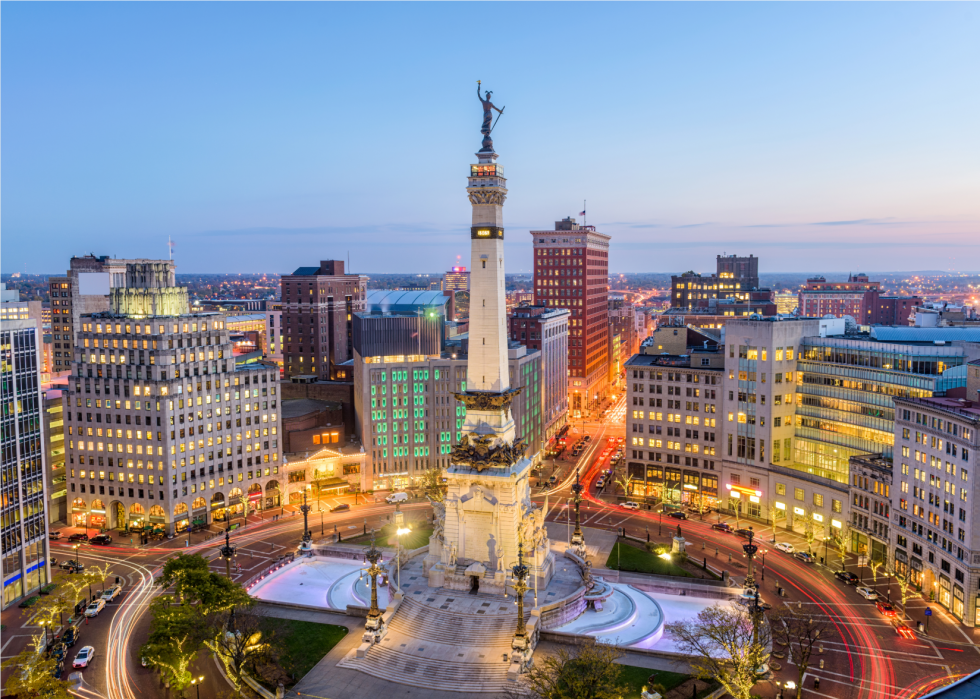
States with the least expensive electricity
Whether it's heating homes, charging cell phones or powering cars, electricity is an important resource used by nearly every home in the United States. The average American household uses about 10,399 kilowatt-hours of electricity per year, according to the U.S. Energy Information Administration (EIA).
Coal was once the primary source of energy for electricity, but as concern over greenhouse gas emissions has intensified, coal use has waned and states across the country have started looking at alternative sources of power. Many states have implemented a Renewable Energy Standard, or RES, in which utility companies are required to source a portion of their energy from renewable resources, such as solar and wind power. Policies vary from state to state and can include mandates to increase renewable usage by 20% in 10 years or to allow non-renewables that are still low polluting, such as natural gas. More than half the states have created some kind of RES, intending to keep costs low for utility companies and consumers, while also creating new solar farms, wind turbines, and hydroelectric facilities.
Wind and solar power have traditionally been more expensive than older power plants, but innovations in technology, along with marketing incentives, have lowered costs in recent years and today's wind farms can generate electricity for less than five cents per kilowatt-hour.
The cost of electricity also can vary widely from state to state and several factors influence prices. This includes power plant and distribution systems operating costs, the availability and use of low-cost hydropower, such as wind turbines, fuel costs, and individual state regulations of utility services.
Stacker reviewed data compiled by the EIA to determine which states have the least expensive electricity costs. Data is for the year 2017 and was released Oct. 12, 2018. Ranked from highest to lowest, using an average price per kilowatt-hour, with any ties broken by average residential price, look at where each of the 50 states falls regarding electricity costs.
You may also like: Most expensive places to live in America

#51. Hawaii
- Average price per kilowatt-hour: 26.05 cents (148.6% higher than national average)
--- Average residential price: 29.50 cents (128.9% higher than national average)
--- Average commercial price: 26.77 cents (151.1% higher than national average)
--- Average industrial price: 22.92 cents (233.1% higher than national average)
--- Average transportation price: Not applicable
Hawaii residents pay some of the highest utility bills in the country. Most of the state's electricity is produced from oil, which is not only one of the most expensive fuels used to generate electricity, it must also be shipped from the mainland, which increases the overall cost. And while solar power might seem like an obvious solution, the excess electricity generated by solar panels can overload circuits and burn up power lines. Hawaii has continued to work to improve energy costs, and according to Hawaii.gov, the state is striving for 100% renewable energy by 2045.

#50. Alaska
- Average price per kilowatt-hour: 19.10 cents (82.3% higher than national average)
--- Average residential price: 21.27 cents (65.0% higher than national average)
--- Average commercial price: 18.89 cents (77.2% higher than national average)
--- Average industrial price: 16.34 cents (137.5% higher than national average)
--- Average transportation price: Not applicable
With its huge oil and gas reserves, it seems that high electricity costs shouldn't be an issue in Alaska. But electricity in the 49th state is more than 80% higher than the national average. The state's small population and harsh winters are both factors, as well as large parcels of undeveloped land between cities that make access to power grids difficult, if not impossible.

#49. Connecticut
- Average price per kilowatt-hour: 17.55 cents (67.5% higher than national average)
--- Average residential price: 20.29 cents (57.4% higher than national average)
--- Average commercial price: 16.06 cents (50.7% higher than national average)
--- Average industrial price: 13.10 cents (90.4% higher than national average)
--- Average transportation price: 10.95 cents (13.1% higher than national average)
Connecticut has the highest electricity rates in the continental United States, primarily because of its dependence on natural gas, which is one of the most expensive fuels used to generate electricity. The state has strict air quality standards that limit the use of coal, and fuel must be transported from other locations as there are no natural gas reserves or underground natural gas storage facilities.

#48. Massachusetts
- Average price per kilowatt-hour: 17.12 cents (63.4% higher than national average)
--- Average residential price: 20.06 cents (55.6% higher than national average)
--- Average commercial price: 15.94 cents (49.5% higher than national average)
--- Average industrial price: 13.88 cents (101.7% higher than national average)
--- Average transportation price: 6.22 cents (35.7% lower than national average)
Electricity in Massachusetts is more than 63% higher than the national average, which is partly because it has to import fossil fuels and has limited natural resources. The climate is not conducive to using solar or wind power, and pipeline development hasn't kept up with the growing energy needs of the region.

#47. Rhode Island
- Average price per kilowatt-hour: 16.42 cents (56.7% higher than national average)
--- Average residential price: 18.32 cents (42.1% higher than national average)
--- Average commercial price: 15.20 cents (42.6% higher than national average)
--- Average industrial price: 14.57 cents (111.8% higher than national average)
--- Average transportation price: 17.08 cents (76.4% higher than national average)
It might be the smallest state in the country, but Rhode Island has some of the biggest electricity bills. Residents pay over 16 cents per kilowatt-hour, which is over 56% higher than the national average. Like other New England states, the region's dependence on imported natural gas is a big contributor to the cost, along with a lack of other resources. The state's Public Utility Commission recently approved an initiative to better maintain utility lines, and to make the state's power grid more accommodating for renewables.

#46. New Hampshire
- Average price per kilowatt-hour: 16.17 cents (54.3% higher than national average)
--- Average residential price: 19.20 cents (49.0% higher than national average)
--- Average commercial price: 14.81 cents (38.9% higher than national average)
--- Average industrial price: 12.34 cents (79.4% higher than national average)
--- Average transportation price: Not applicable
New Hampshire's electricity costs are about 16 cents per kilowatt-hour, putting it at just over 53% higher than the rest of the country, while still being lower than most neighboring states. Transportation and distribution costs are factors, as well as restrictions on the use of coal, which is less expensive but also less environmentally friendly.

#45. California
- Average price per kilowatt-hour: 16.06 cents (53.2% higher than national average)
--- Average residential price: 18.31 cents (42% higher than national average)
--- Average commercial price: 15.76 cents (47.8% higher than national average)
--- Average industrial price: 12.73 cents (85% higher than national average)
--- Average transportation price: 8.68 cents (10.3% lower than national average)
Despite having electricity costs that are over 53% higher than other parts of the United States, the state of California generates more electricity than it needs. The higher costs of power are considered to be partly because of a focus on developing renewable energy sources, such as wind and solar power, both of which are expensive to maintain and manage.

#44. New York
- Average price per kilowatt-hour: 14.74 cents (40.6% higher than national average)
--- Average residential price: 18.03 cents (39.9% higher than national average)
--- Average commercial price: 14.75 cents (38.4% higher than national average)
--- Average industrial price: 5.92 cents (14% lower than national average)
--- Average transportation price: 12.67 cents (30.9% higher than national average)
Residents of New York pay an average of 14.74 cents per kilowatt-hour for electricity, which is about 40% higher than the national average. Most of New York's power comes from privately owned power plants. The plants that produce natural gas generate nearly half of the usable electricity, followed by hydroelectric facilities, which produce about 19%.

#43. Vermont
- Average price per kilowatt-hour: 14.60 cents (39.3% higher than national average)
--- Average residential price: 17.68 cents (37.2% higher than national average)
--- Average commercial price: 14.61 cents (37.1% higher than national average)
--- Average industrial price: 10.21 cents (48.4% higher than national average)
--- Average transportation price: Not applicable
Vermont, whose average kilowatt-hour price is over 39% higher than the national average, produces about 40% of the electricity it uses. It depends on power from neighboring states and Canadian hydro dams for the rest. Vermont enacted an integrated renewable energy standard in 2015, with the goal of having 75% of its energy coming from renewable sources by 2032.

#42. New Jersey
- Average price per kilowatt-hour: 13.32 cents (27.1% higher than national average)
--- Average residential price: 15.65 cents (21.4% higher than national average)
--- Average commercial price: 12.28 cents (15.2% higher than national average)
--- Average industrial price: 10.12 cents (47.1% higher than national average)
--- Average transportation price: 8.81 cents (9% lower than national average)
New Jersey generates most of its electricity via natural gas power plants and nuclear power stations. The state's costly utilities stem in part from increased expenses in trying to comply with state mandates on renewable energy, as well as subsidies paid to the remaining nuclear plants, which have faced the possibility of closure in recent years. The nuclear plants provide 40% of the state's electricity with minimal emissions.

#41. Maine
- Average price per kilowatt-hour: 13.02 cents (24.2% higher than national average)
--- Average residential price: 15.97 cents (23.9% higher than national average)
--- Average commercial price: 12.12 cents (13.7% higher than national average)
--- Average industrial price: 9.20 cents (33.7% higher than national average)
--- Average transportation price: Not applicable
Maine's kilowatt-hour cost runs over 24% higher than the rest of the country, and the state gets much of its energy from hydroelectric dams and wood biomass products. Maine also gets a good portion of its power from wind, and as of 2018, wind turbines accounted for two-thirds of wind-powered energy in New England.

#40. Maryland
- Average price per kilowatt-hour: 11.98 cents (14.3% higher than national average)
--- Average residential price: 13.96 cents (8.3% higher than national average)
--- Average commercial price: 10.75 cents (0.8% higher than national average)
--- Average industrial price: 8.37 cents (21.7% higher than national average)
--- Average transportation price: 7.74 cents (20% lower than national average)
Most of Maryland's electricity comes from coal-fired power plants, which supply almost 70% of the state's electricity. While some coal-fired plants have implemented emissions controls to meet federal requirements, the high cost of the improvements has pushed up the already high cost of electricity for residents. As a result, some operators have requested these plants be deactivated and replaced with less-expensive natural gas facilities.

#39. Washington D.C.
- Average price per kilowatt-hour: 11.80 cents (12.6% higher than national average)
--- Average residential price: 12.94 cents (0.4% higher than national average)
--- Average commercial price: 11.66 cents (9.4% higher than national average)
--- Average industrial price: 8.23 cents (19.6% higher than national average)
--- Average transportation price: 8.90 cents (8.1% lower than national average)
The District of Columbia, which has higher-than-average electricity costs, also has a large concentration of government buildings and dense commercial areas, which account for more than 70% of electricity sales. Most of the district's electricity comes from natural gas, but a recently approved law will require that all of D.C.'s electricity come from renewable resources such as wind and solar by 2032.

#38. Michigan
- Average price per kilowatt-hour: 11.28 cents (7.6% higher than national average)
--- Average residential price: 15.40 cents (19.5% higher than national average)
--- Average commercial price: 11.00 cents (3.2% higher than national average)
--- Average industrial price: 7.19 cents (4.5% higher than national average)
--- Average transportation price: 11.99 cents (23.9% higher than national average)
Michigan used to get most of its electricity from coal-fired plants, but as of 2018, natural gas had taken over as the supplier for much of the state's energy. Three nuclear power plants generate about one-fourth of the state's electricity, and wind turbines account for about 5%. Michigan has about two dozen wind farms in operation, and that number is expected to grow as demands for renewable energy increase.

#37. Delaware
- Average price per kilowatt-hour: 10.91 cents (4.1% higher than national average)
--- Average residential price: 13.35 cents (3.6% higher than national average)
--- Average commercial price: 9.89 cents (7.2% lower than national average)
--- Average industrial price: 7.78 cents (13.1% higher than national average)
--- Average transportation price: Not applicable
Delaware gets most of its electricity from natural gas, but the state's inventive use of renewable energy sources could potentially outpace the use of natural gas soon. Committed to using renewable resources for at least 25% of electricity needs by 2025, officials have promoted and increased the use of solar power, and the Delaware Electric Cooperative has started to produce electricity by harvesting methane gases from landfills.

#36. Wisconsin
- Average price per kilowatt-hour: 10.76 cents (2.7% higher than national average)
--- Average residential price: 14.35 cents (11.3% higher than national average)
--- Average commercial price: 10.87 cents (2% higher than national average)
--- Average industrial price: 7.49 cents (8.9% higher than national average)
--- Average transportation price: 14.31 cents (47.8% higher than national average)
Wisconsin pays just under 11 cents per kilowatt-hour for electricity, slightly higher than the national average. The state gets most of its electricity from coal, followed by natural gas and renewable resources. The state has worked to increase use of renewable energy resources, and recent initiatives have committed it to having at least 30% of electricity sales coming from renewable sources by 2030.

#35. Arizona
- Average price per kilowatt-hour: 10.64 cents (1.5% higher than national average)
--- Average residential price: 12.44 cents (3.5% lower than national average)
--- Average commercial price: 10.50 cents (1.5% lower than national average)
--- Average industrial price: 6.45 cents (6.3% lower than national average)
--- Average transportation price: 9.65 cents (0.3% lower than national average)
Electricity in Arizona comes primarily from nuclear power, coal, and natural gas. The Palo Verde Nuclear Generating Station is the second-largest power plant of its capacity in the nation. While coal was once the state's main energy supplier, there is just one remaining operational coal mine, on the Navajo and Hopi Indian reservations, and that mine will close in 2019.

#34. Kansas
- Average price per kilowatt-hour: 10.60 cents (1.1% higher than national average)
--- Average residential price: 13.31 cents (3.3% higher than national average)
--- Average commercial price: 10.59 cents (0.7% lower than national average)
--- Average industrial price: 7.54 cents (9.6% higher than national average)
--- Average transportation price: Not applicable
Electricity costs in Kansas are only 1% above the national average, with most energy needs met by natural gas, coal, and nuclear power. The state has 16 natural gas storage fields and is the country's 10th-largest crude-oil producer. Its Renewable Energy Standard set a goal to increase the use of renewable resources to 20% by 2020, and as of 2018, the state ranked in the top five in wind energy production.

#33. Florida
- Average price per kilowatt-hour: 10.42 cents (0.6% lower than national average)
--- Average residential price: 11.61 cents (9.9% lower than national average)
--- Average commercial price: 9.35 cents (12.3% lower than national average)
--- Average industrial price: 7.83 cents (13.8% higher than national average)
--- Average transportation price: 8.62 cents (11% lower than national average)
One of the largest producers of energy in the nation, most of Florida's electricity comes from natural gas. The state has several large gas-fired power plants, as well as nuclear power plants that provide additional energy. Despite the amount of electricity generated in the state, Florida still doesn't produce enough electricity to meet power demands. As electricity needs continue to grow, solar power is anticipated to become more popular. A new solar farm was recently completed by Duke Energy in Jasper, which can provide renewable energy for upwards of 20,000 homes.

#32. Minnesota
- Average price per kilowatt-hour: 10.27 cents (2% lower than national average)
--- Average residential price: 13.04 cents (1.2% higher than national average)
--- Average commercial price: 10.48 cents (1.7% lower than national average)
--- Average industrial price: 7.37 cents (7.1% higher than national average)
--- Average transportation price: 9.56 cents (1.2% lower than national average)
Electricity in Minnesota was originally powered by coal. As the focus on renewable energy has shifted and the cost of wind and solar power generation has gone down, Minnesota has moved away from coal and increased its use of nuclear power, wind, and solar. The state's Renewable Energy Standard requires that utility companies get at least 25% of their power from renewables by 2025. While coal still powers much of the electricity, the state has worked to reduce its use of coal. As of 2018, coal use had dropped from over 50% to 37%.

#31. Pennsylvania
- Average price per kilowatt-hour: 10.13 cents (3.3% lower than national average)
--- Average residential price: 14.23 cents (10.4% higher than national average)
--- Average commercial price: 8.98 cents (15.8% lower than national average)
--- Average industrial price: 6.77 cents (1.6% lower than national average)
--- Average transportation price: 7.16 cents (26% lower than national average)
Pennsylvania's per-kilowatt-hour costs are slightly below the national average, while residential prices are slightly higher. The state gets most of its electricity from nuclear power and natural gas. Over one-third of the state's power is consumed by residents, and about one in five homes uses electricity for heat. The state has large natural gas reserves and regularly ships gas to other regions, such as New England.

#30. South Dakota
- Average price per kilowatt-hour: 10.05 cents (4.1% lower than national average)
--- Average residential price: 11.77 cents (8.7% lower than national average)
--- Average commercial price: 9.74 cents (8.6% lower than national average)
--- Average industrial price: 7.84 cents (14% higher than national average)
--- Average transportation price: Not applicable
Most of South Dakota is powered by hydroelectric facilities, with several large dams on the upper Missouri River. The state also uses coal and wind, and usage of wind power has increased from just 2% to about 25% in recent years, while coal has subsequently declined.

#29. Missouri
- Average price per kilowatt-hour: 10.03 cents (4.3% lower than national average)
--- Average residential price: 11.63 cents (9.8% lower than national average)
--- Average commercial price: 9.47 cents (11.2% lower than national average)
--- Average industrial price: 7.33 cents (6.5% higher than national average)
--- Average transportation price: 8.42 cents (13% lower than national average)
Missouri's electricity is primarily generated by coal, with more than 70% of the state's electricity coming from coal-fired plants. There is just one nuclear power plant, which provides about 18% of electrical power, and as of 2018, the state's 500 wind turbines contributed about 1,000 megawatts of power.

#28. Colorado
- Average price per kilowatt-hour: 9.99 cents (4.7% lower than national average)
--- Average residential price: 12.17 cents (5.6% lower than national average)
--- Average commercial price: 9.89 cents (7.2% lower than national average)
--- Average industrial price: 7.50 cents (9% higher than national average)
--- Average transportation price: 9.77 cents (0.9% higher than national average)
A resource-rich state, Colorado uses its large natural gas fields and coal-fired plants to meet most of its energy needs. Commercial areas consume nearly two-fifths of the state's power and over one in five households uses electricity for heat, but overall electricity consumption is much lower per capita than most other states. Renewable energy has increased in recent years, with wind power generation nearly doubling from 2010 to 2018.

#27. South Carolina
- Average price per kilowatt-hour: 9.97 cents (4.9% lower than national average)
--- Average residential price: 13.02 cents (1% higher than national average)
--- Average commercial price: 10.57 cents (0.8% lower than national average)
--- Average industrial price: 6.19 cents (10% lower than national average)
--- Average transportation price: Not applicable
South Carolina enjoys lower per-kilowatt-hour prices for electricity than many other states, but has a slightly higher average residential price. Most of the electricity is generated by nuclear power, and there are several large power plants across the state. Coal still provides nearly one-fifth of the electricity used, but hydropower and biomass has grown and now generates about 6% of the state's electricity. Biomass fuel from forest debris is collected near the Savannah River as a replacement for coal-fired energy and there are several hydropower facilities with more potentially on the horizon.

#26. Ohio
- Average price per kilowatt-hour: 9.84 cents (6.1% lower than national average)
--- Average residential price: 12.63 cents (2% lower than national average)
--- Average commercial price: 10.05 cents (5.7% lower than national average)
--- Average industrial price: 6.92 cents (0.6% higher than national average)
--- Average transportation price: 7.50 cents (22.5% lower than national average)
Ohio is on its way to becoming a major natural gas and oil producer, mainly because of drilling in the Utica Shale, which began in 2011. As of 2018, natural gas production in Ohio was more than 28 times higher than in 2012. Coal is still the primary fuel for electricity, but as natural gas production has grown, more coal-fired plants have been retired.

#25. Alabama
- Average price per kilowatt-hour: 9.83 cents (6.2% lower than national average)
--- Average residential price: 12.55 cents (2.6% lower than national average)
--- Average commercial price: 11.60 cents (8.8% higher than national average)
--- Average industrial price: 6.16 cents (10.5% lower than national average)
--- Average transportation price: Not applicable
One of the country's biggest electricity producers, the state of Alabama is rich in natural energy resources with large coal deposits, natural gas, and crude oil. Most of the electricity used is generated from natural gas. Its average per-kilowatt-hour price is 6.2% lower than the national average, despite its higher-than-average consumption of electricity for air conditioning during the hot, humid summers.

#24. Georgia
- Average price per kilowatt-hour: 9.83 cents (6.2% lower than national average)
--- Average residential price: 11.90 cents (7.7% lower than national average)
--- Average commercial price: 10.09 cents (5.3% lower than national average)
--- Average industrial price: 5.96 cents (13.4% lower than national average)
--- Average transportation price: 5.35 cents (44.7% lower than national average)
Electricity in Georgia is fueled primarily by natural gas, nuclear power, and coal, with a small percentage of energy coming from renewable resources. One of the top 10 in energy consumption, the state imports 10 to 15% of the electricity it needs from other states, although its overall energy consumption is actually lower per capita. Its two nuclear power plants provide about one-fourth of the state's electricity, and two new reactors are being built, which might double the output.

#23. Indiana
- Average price per kilowatt-hour: 9.77 cents (6.8% lower than national average)
--- Average residential price: 12.29 cents (4.7% lower than national average)
--- Average commercial price: 10.54 cents (1.1% lower than national average)
--- Average industrial price: 7.54 cents (9.6% higher than national average)
--- Average transportation price: 11.23 cents (16% higher than national average)
Most of Indiana's electricity comes from coal, with a smaller amount generated by natural gas and renewables. The economy relies heavily on industry, with manufacturing plants that produce aluminum, glass, steel, and chemicals. These plants consume more energy than both residential and commercial sectors, and while Indiana's overall energy rates are less expensive than many other states, electricity prices have increased by over 28% in the past 10 years. Average per-kilowatt-hour prices are still lower than the national average, except for the industrial sector which is almost 10% higher.

#22. New Mexico
- Average price per kilowatt-hour: 9.59 cents (8.5% lower than national average)
--- Average residential price: 12.88 cents (0.1% lower than national average)
--- Average commercial price: 10.19 cents (4.4% lower than national average)
--- Average industrial price: 6.15 cents (10.6% lower than national average)
--- Average transportation price: Not applicable
Coal accounts for over half of New Mexico's electricity generation, followed by natural gas and renewable resources. Coal generation has decreased in recent years, with natural gas now accounting for over one-fourth of electricity generation. Most of the electricity is consumed by the commercial sector, with residential use not far behind. One in five homes uses electricity for heat.

#21. Illinois
- Average price per kilowatt-hour: 9.49 cents (9.4% lower than national average)
--- Average residential price: 12.95 cents (0.5% higher than national average)
--- Average commercial price: 9.09 cents (14.7% lower than national average)
--- Average industrial price: 6.47 cents (6% lower than national average)
--- Average transportation price: 6.35 cents (34.4% lower than national average)
Illinois has six nuclear power plants that provide over 52% of the state's electricity, making it one of the country's top producers of nuclear power. It is also one of the largest energy exporters, sending about one-fifth of its generated power to other states. While most Illinois residents have air conditioning, only one in six homes uses electricity for heat.

#20. Tennessee
- Average price per kilowatt-hour: 9.45 cents (9.8% lower than national average)
--- Average residential price: 10.72 cents (16.8% lower than national average)
--- Average commercial price: 10.55 cents (1% lower than national average)
--- Average industrial price: 5.83 cents (15.3% lower than national average)
--- Average transportation price: Not applicable
Coal was Tennessee's primary energy resource for many years, but as restrictions on carbon dioxide emissions have increased and prices for other power sources have declined, many of the coal-fired plants have been retired. The state gets almost half of its electricity from nuclear power, followed by coal, natural gas, and renewables. Tennessee's Integrated Resource Plan includes an increase in the use of solar power, which officials anticipate will gain popularity over time.

#19. Virginia
- Average price per kilowatt-hour: 9.18 cents (12.4% lower than national average)
--- Average residential price: 11.55 cents (10.4% lower than national average)
--- Average commercial price: 8.01 cents (24.9% lower than national average)
--- Average industrial price: 6.51 cents (5.4% lower than national average)
--- Average transportation price: 8.11 cents (16.2% lower than national average)
Virginia's electricity prices are between 5.4 and 24.9% lower than other parts of the country, in part because natural gas, often less expensive than other resources, fuels more than half of the electricity needs. Additionally, the state Corporation Commission recently issued a directive requiring two of Virginia's power companies to share benefits from a corporate tax cut passed in 2017, which will result in credits to customers and overall lower energy rates.

#18. Mississippi
- Average price per kilowatt-hour: 9.09 cents (13.3% lower than national average)
--- Average residential price: 11.08 cents (14% lower than national average)
--- Average commercial price: 10.17 cents (4.6% lower than national average)
--- Average industrial price: 5.99 cents (12.9% lower than national average)
--- Average transportation price: Not applicable
One of the few states with large underground salt caverns that can store natural gas, Mississippi sits atop nearly 4% of the total storage capacity in the country. Natural gas is used for close to four-fifths of electricity output, followed by nuclear power, coal, and biomass. While more than half the homes in the state use electricity for heat, most of the energy the state uses is consumed by the transportation and industrial sectors.

#17. Nebraska
- Average price per kilowatt-hour: 9.08 cents (13.4% lower than national average)
--- Average residential price: 10.97 cents (14.9% lower than national average)
--- Average commercial price: 8.85 cents (17% lower than national average)
--- Average industrial price: 7.66 cents (11.3% higher than national average)
--- Average transportation price: Not applicable
Nebraska's average price per kilowatt-hour runs about 13% lower than the national average. The state gets 63% of its energy from coal, 15% from nuclear power, and 14% from wind. Consumption of electricity is mainly by industry, especially on farms that use electricity for irrigation.

#16. North Carolina
- Average price per kilowatt-hour: 9.04 cents (13.7% lower than national average)
--- Average residential price: 10.94 cents (15.1% lower than national average)
--- Average commercial price: 8.44 cents (20.8% lower than national average)
--- Average industrial price: 6.20 cents (9.9% lower than national average)
--- Average transportation price: 8.55 cents (11.7% lower than national average)
Nuclear energy, natural gas, and coal are the predominant suppliers of electricity in North Carolina, but renewables are on the rise. Home to the largest wind farm in the Southeast and second only to California in the number of installed solar units, North Carolina has made clean energy a focus in recent years, with the governor pledging to reduce greenhouse emissions by 40% by 2025. The state's wind farm has a generating capacity of 208 megawatts, and solar power has a 4,400 megawatt capacity.

#15. West Virginia
- Average price per kilowatt-hour: 9.00 cents (14.1% lower than national average)
--- Average residential price: 11.63 cents (9.8% lower than national average)
--- Average commercial price: 9.58 cents (10.1% lower than national average)
--- Average industrial price: 6.64 cents (3.5% lower than national average)
--- Average transportation price: Not applicable
More than 90% of West Virginia's electricity is powered by coal, and coal mining is a big part of the state's economy. The industrial sector, which includes coal, oil, and natural gas extraction, accounts for nearly 40% of the state's energy use, followed by transportation industries. The state is ranked fifth in the country in total energy production, and is one of the largest coal producers in the country.

#14. Montana
- Average price per kilowatt-hour: 8.92 cents (14.9% lower than national average)
--- Average residential price: 10.95 cents (15.1% lower than national average)
--- Average commercial price: 10.12 cents (5.1% lower than national average)
--- Average industrial price: 5.25 cents (23.7% lower than national average)
--- Average transportation price: Not applicable
Montana residents enjoy average per-kilowatt-hour prices that are nearly 15% lower than the rest of the country. Despite hot summers and extreme winters, the low population means that the residential sector consumes much less energy overall. Rich in both fossil fuels and renewable resources, Montana also supplies a significant amount of energy to the rest of the United States.

#13. Oregon
- Average price per kilowatt-hour: 8.81 cents (15.9% lower than national average)
--- Average residential price: 10.66 cents (17.3% lower than national average)
--- Average commercial price: 8.86 cents (16.9% lower than national average)
--- Average industrial price: 5.98 cents (13.1% lower than national average)
--- Average transportation price: 9.35 cents (3.4% lower than national average)
Oregon's energy comes from several resources, including hydroelectricity, coal, wind, and nuclear power. Consuming an average of 48,157,378 megawatt hours of electricity per year, hydroelectric power plants and other renewable resources provide about 76% of that energy. Wind farms have over 3,200 megawatts of generating capacity, and the state is one of the top hydroelectric power producers in the country.

#12. North Dakota
- Average price per kilowatt-hour: 8.78 cents (16.2% lower than national average)
--- Average residential price: 10.29 cents (20.2% lower than national average)
--- Average commercial price: 9.19 cents (13.8% lower than national average)
--- Average industrial price: 7.63 cents (10.9% higher than national average)
--- Average transportation price: Not applicable
Coal-fired power supplies North Dakota with most of its electricity, providing over 60% of the energy needed. The state's small population makes it one of the lowest consumers of electricity in the United States, and about half the electricity generated in North Dakota is sent to regional electricity grids connecting to other states. Most of the electricity used in the state goes to the industrial sector, followed by transportation.

#11. Nevada
- Average price per kilowatt-hour: 8.76 cents (16.4% lower than national average)
--- Average residential price: 11.99 cents (7% lower than national average)
--- Average commercial price: 7.96 cents (25.3% lower than national average)
--- Average industrial price: 6.15 cents (10.6% lower than national average)
--- Average transportation price: 8.61 cents (11.1% lower than national average)
Despite being home to the famous Hoover Dam, Nevada gets most of its electricity from natural gas, and the bulk of the energy from the Hoover Dam goes to California and Arizona. Overall electricity consumption is higher in Nevada than in other states, with the industrial sectors consuming the lion's share, followed by residential areas. Average residential prices are 7% lower than the national average, and commercial prices are over 25% lower.

#10. Iowa
- Average price per kilowatt-hour: 8.73 cents (16.7% lower than national average)
--- Average residential price: 12.34 cents (4.3% lower than national average)
--- Average commercial price: 9.46 cents (11.3% lower than national average)
--- Average industrial price: 6.21 cents (9.7% lower than national average)
--- Average transportation price: Not applicable
While coal has always been the primary supplier of energy for the state of Iowa, it has been consistently declining in use, from 76% in 2008 to 45% in 2018. Natural gas now leads the way in energy production, while wind turbines generate 34% of the state's electricity, which is the second-highest share in the country.

#9. Utah
- Average price per kilowatt-hour: 8.60 cents (17.9% lower than national average)
--- Average residential price: 10.95 cents (15.1% lower than national average)
--- Average commercial price: 8.65 cents (18.9% lower than national average)
--- Average industrial price: 6.13 cents (10.9% lower than national average)
--- Average transportation price: 10.26 cents (6% higher than national average)
With resources that include coal, natural gas, and crude oil, as well as various types of renewables, Utah produces more energy than it needs and supplies energy to several nearby states. Royalties from energy development are among the state's primary sources of income, and with a relatively small population, energy consumption per capita is low. The state also has the only operating uranium mill in the country, selling processed uranium to make fuel rods for nuclear plants.

#8. Kentucky
- Average price per kilowatt-hour: 8.57 cents (18.2% lower than national average)
--- Average residential price: 10.85 cents (15.8% lower than national average)
--- Average commercial price: 9.85 cents (7.6% lower than national average)
--- Average industrial price: 5.72 cents (16.9% lower than national average)
--- Average transportation price: Not applicable
Kentucky's per-kilowatt-hour electricity prices are 18% lower than the national average, making it one of the least-expensive states for energy costs. As of 2018, coal-fired power accounted for 75% of the electricity generated, followed by natural gas and hydroelectric plants. The industrial sector claims most of the electricity usage, despite nearly half of the homes in Kentucky using electricity as the main heat source.

#7. Texas
- Average price per kilowatt-hour: 8.38 cents (20% lower than national average)
--- Average residential price: 11.01 cents (14.6% lower than national average)
--- Average commercial price: 8.26 cents (22.5% lower than national average)
--- Average industrial price: 5.35 cents (22.2% lower than national average)
--- Average transportation price: 8.16 cents (15.7% lower than national average)
Texas isn't just the largest energy producer, it's also the largest consumer. With 29 petroleum refineries and an industry-focused economy, the industrial sector consumes half the energy used by the state, with residential areas accounting for only one-eighth of the energy used. Texas also leads in wind power, with wind turbines that have consistently produced more power than the state's nuclear power plants since 2014.

#6. Wyoming
- Average price per kilowatt-hour: 8.28 cents (21% lower than national average)
--- Average residential price: 11.37 cents (11.8% lower than national average)
--- Average commercial price: 9.70 cents (9% lower than national average)
--- Average industrial price: 6.92 cents (0.6% higher than national average)
--- Average transportation price: Not applicable
While one in five households has electricity for heat in Wyoming, the state's small population keeps energy use at a minimum. Coal provides about 85% of the electricity needed, and the use of wind turbines has grown in recent years, providing close to 10% of the energy for the state.

#5. Arkansas
- Average price per kilowatt-hour: 8.26 cents (21.2% lower than national average)
--- Average residential price: 10.28 cents (20.2% lower than national average)
--- Average commercial price: 8.51 cents (20.2% lower than national average)
--- Average industrial price: 6.07 cents (11.8% lower than national average)
--- Average transportation price: 12.26 cents (26.7% higher than national average)
Arkansas' electricity prices range from 11.8 to 21.2% lower than the national average, except for transportation costs, which are just over 26% higher. Coal-fired power provides a portion of the electricity used, with natural gas fueling the most. They generate the small remainder from hydroelectric and biomass facilities.

#4. Idaho
- Average price per kilowatt-hour: 8.26 cents (21.2% lower than national average)
--- Average residential price: 10.04 cents (22.1% lower than national average)
--- Average commercial price: 7.98 cents (25.1% lower than national average)
--- Average industrial price: 6.66 cents (3.2% lower than national average)
--- Average transportation price: Not applicable
More than half of Idaho's electricity is generated in-state, primarily with hydroelectric power. The remainder is supplied by natural gas and renewables such as wind power. Because most of the electricity comes from hydropower, which is inexpensive, Idaho residents enjoy some of the lowest electricity bills in the nation.

#3. Oklahoma
- Average price per kilowatt-hour: 8.20 cents (21.8% lower than national average)
--- Average residential price: 10.61 cents (17.7% lower than national average)
--- Average commercial price: 8.11 cents (23.9% lower than national average)
--- Average industrial price: 5.42 cents (21.2% lower than national average)
--- Average transportation price: Not applicable
The sixth-largest crude oil producer in the country, Oklahoma has five operating petroleum refineries that put out over 500,000 barrels per day. While the state's largest energy plant is coal-fired, coal use has steadily declined and now supplies less than one-fourth of the electricity. Almost one-third of the energy comes from renewable resources such as wind, making the state second only to Texas in electricity generation from wind power.

#2. Washington
- Average price per kilowatt-hour: 7.94 cents (24.2% lower than national average)
--- Average residential price: 9.66 cents (25.1% lower than national average)
--- Average commercial price: 8.57 cents (19.6% lower than national average)
--- Average industrial price: 4.60 cents (33.1% lower than national average)
--- Average transportation price: 9.18 cents (5.2% lower than national average)
Washington's average price per kilowatt-hour is over 24% lower than the national average, and residential prices are more than 25% lower. Most of the state's energy comes from hydroelectric power, including the Grand Coulee Dam, which is the sixth-largest hydroelectric power plant in the world. Because hydroelectric power is one of the least expensive to generate, residents' electricity costs are substantially lower than the rest of the country.

#1. Louisiana
- Average price per kilowatt-hour: 7.79 cents (25.7% lower than national average)
--- Average residential price: 9.74 cents (24.4% lower than national average)
--- Average commercial price: 8.95 cents (16% lower than national average)
--- Average industrial price: 5.48 cents (20.3% lower than national average)
--- Average transportation price: 9.93 cents (2.6% higher than national average)
Half of Louisiana's 10 largest power plants are fueled by natural gas, which provides the bulk of the state's electricity needs. Nuclear power contributes about 17%, followed by renewables, such as biomass and solar. Louisiana's per-kilowatt-hour electricity costs are about 25% less than the rest of the country, despite most homes having air conditioning and six out of 10 homes using electricity for heat.



